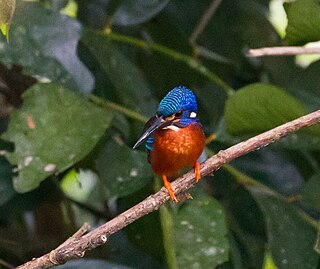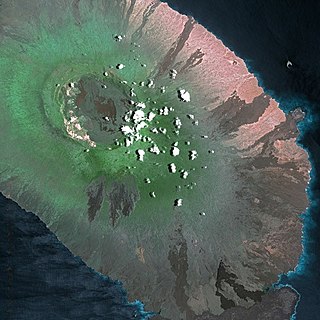
The common kingfisher also known as the Eurasian kingfisher, and river kingfisher, is a small kingfisher with seven subspecies recognized within its wide distribution across Eurasia and North Africa. It is resident in much of its range, but migrates from areas where rivers freeze in winter.

The half-collared kingfisher is a kingfisher in the subfamily Alcedininae that is found in southern and eastern Africa. It feeds almost exclusively on fish and frequents streams, rivers and larger bodies of water.
Antonio de Alcedo (1735–1812) was a Spanish soldier and scholar.

The blue-eared kingfisher is found in Asia, ranging across the Indian subcontinent and Southeast Asia. It is found mainly in dense shaded forests where it hunts in small streams. It is darker crowned, with darker rufous underparts and lacking the rufous ear stripe of the common kingfisher which is found in more open habitats. A number of subspecies have been described that differ in measurement and colour shade. Adult males have an all dark bill while females have a reddish lower mandible.

Blyth's kingfisher is the largest kingfisher in the genus Alcedo. Named for Edward Blyth, the species has also been known as Alcedo grandis and as the great blue kingfisher. Between 22 and 23 centimetres long, the kingfisher has deep rufous underparts with a blackish blue breast patch, and brilliant cobalt blue or azure upperparts, tinged with purple. The wings are a dark blackish green, with blue speckles and tips to some of the feathers. The bill of the male is entirely black, while the female has a dark red lower mandible. The species is distinguished from the similar blue-eared kingfisher and common kingfisher by its greater size, heavy black bill, and dark lores.

Alcedo is a genus of birds in the kingfisher subfamily Alcedininae. The genus was introduced by Carl Linnaeus in 1758 in the 10th edition of his Systema Naturae. The type species is the common kingfisher. Alcedo is the Latin for "kingfisher".

The blue-banded kingfisher, is a species of kingfisher in the subfamily Alcedininae. Its natural habitats are subtropical or tropical moist lowland forest, subtropical or tropical mangrove forest, and rivers.

The shining-blue kingfisher is a species of bird in the family Alcedinidae. It is found in Equatorial Africa.

Ceyx is an Old World genus of river kingfishers. These kingfishers are found from South East Asia to the Solomon Islands.
Coreura is a genus of moths in the subfamily Arctiinae.

Alcedo Volcano is one of the six coalescing shield volcanoes that make up Isabela Island in the Galapagos. The remote location of the volcano has meant that even the most recent eruption in 1993 was not recorded until two years later. It is also the only volcano in the Galapagos to have erupted rhyolite and basaltic lava.
Coreura albicosta is a moth of the subfamily Arctiinae. It was described by Max Wilhelm Karl Draudt in 1915. It is found in Mexico.
Coreura cerealia is a moth of the subfamily Arctiinae. It was described by Druce in 1897. It is found in Ecuador.
Coreura eion is a moth of the subfamily Arctiinae. It was described by Druce in 1896. It is found in Costa Rica and Panama.
Coreura engelkei is a moth of the subfamily Arctiinae. It was described by Rothschild in 1912. It is found in Colombia.
Coreura fida is a moth of the subfamily Arctiinae. It was described by Hübner in 1827. It is found in Mexico and Brazil.
Coreura interposita is a moth of the subfamily Arctiinae. It was described by George Hampson in 1901. It is found in Venezuela.
Coreura lysimachides is a moth of the subfamily Arctiinae. It was described by Druce in 1897. It is found in Ecuador and Peru.
Coreura simsoni is a moth of the subfamily Arctiinae. It was described by Druce in 1885. It is found in Colombia, Ecuador and Bolivia.
Coreura sinerubra is a moth of the subfamily Arctiinae. It was described by Kaye in 1919. It is found in Peru.










